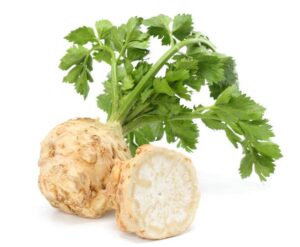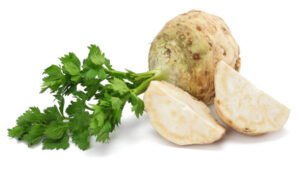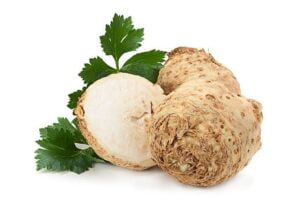Celery root, also known as celeriac, is a nutritious vegetable that often goes unnoticed in comparison to its better-known counterpart, celery stalks. Despite its humble appearance, celery root harbors a plethora of health benefits backed by scientific research. From aiding digestion to bolstering immunity, its consumption offers a myriad of advantages for overall well-being.
 Digestive Health
Digestive Health
One of the primary benefits of celery root consumption lies in its ability to promote digestive health. It is a natural source of dietary fiber, comprising both soluble and insoluble fibers. These fibers facilitate smooth bowel movements, prevent constipation, and support a healthy gut microbiome by serving as nourishment for beneficial gut bacteria. Additionally, the fiber content aids in weight management by promoting satiety and regulating appetite.
Moreover, celery root contains phytochemicals such as apiuman, a type of polysaccharide unique to celery, which has been studied for its potential prebiotic effects. Prebiotics are substances that selectively stimulate the growth and activity of beneficial bacteria in the gut, promoting a balanced microbiome and enhancing digestive function. By nourishing these beneficial microbes, celery root supports the production of short-chain fatty acids (SCFAs), which play a crucial role in maintaining intestinal integrity and regulating immune function.
Additionally, celery root is rich in vitamins, minerals, and antioxidants, including vitamin C, potassium, and flavonoids. These nutrients help to combat inflammation in the digestive tract, reduce oxidative stress, and protect against gastrointestinal disorders. Furthermore, celery root contains natural enzymes that aid in the breakdown and absorption of nutrients, ensuring optimal nutrient utilization and supporting overall digestive efficiency.
 Anti-Inflammatory Properties
Anti-Inflammatory Properties
Celery root contains compounds with potent anti-inflammatory properties, such as flavonoids and polyphenols. These bioactive compounds help reduce inflammation throughout the body, potentially mitigating the risk of chronic diseases like arthritis, cardiovascular diseases, and certain types of cancer. Regular consumption of celery root may contribute to overall inflammation management and promote long-term health.
In addition to its flavonoids and polyphenols, celery root contains unique compounds that set it apart in terms of its anti-inflammatory properties. One such compound is apigenin, a flavone with potent anti-inflammatory effects. Studies have shown that apigenin can inhibit the production of pro-inflammatory cytokines and enzymes, thereby reducing inflammation in the body.
Furthermore, celery root is rich in a class of antioxidants known as phthalides, which have been specifically linked to anti-inflammatory activity. Phthalides not only help to combat inflammation but also contribute to the relaxation of blood vessels, potentially aiding in the regulation of blood pressure and cardiovascular health.
Moreover, celery root contains significant amounts of vitamin C, a powerful antioxidant known for its anti-inflammatory properties. Vitamin C plays a crucial role in scavenging free radicals and reducing oxidative stress, which are key contributors to inflammation and chronic disease development.
 Blood Pressure Regulation
Blood Pressure Regulation
Potassium, a mineral abundant in celery root, plays a pivotal role in regulating blood pressure. Adequate potassium intake helps counteract the effects of sodium, thereby reducing the risk of hypertension and associated cardiovascular complications. Incorporating celery root into a balanced diet can contribute to maintaining healthy blood pressure levels and promoting cardiovascular well-being.
In addition to its high potassium content, celery root contains compounds like phthalides, which are known for their potential to dilate blood vessels and improve blood flow. These compounds work synergistically with potassium to enhance the vasodilatory effects, further aiding in the maintenance of healthy blood pressure levels.
Furthermore, celery root is rich in antioxidants such as vitamin C and flavonoids, which help protect blood vessels from oxidative damage. By reducing oxidative stress, celery root contributes to the preservation of endothelial function, crucial for regulating blood pressure and preventing hypertension-related complications.
Moreover, the fiber content in celery root plays a significant role in blood pressure management. Dietary fiber promotes satiety and helps control weight, a key factor in blood pressure regulation. Additionally, soluble fiber in celery root can bind to cholesterol in the digestive tract, limiting its absorption and subsequently reducing the risk of atherosclerosis, a condition that can lead to hypertension and cardiovascular disease.
 Immune System Support
Immune System Support
The high vitamin C content in celery root enhances immune function by stimulating the production of white blood cells and antibodies, crucial components of the body’s defense against infections and illnesses. By fortifying the immune system, celery root consumption may help ward off common colds, flu, and other respiratory infections, especially during periods of heightened vulnerability.
Apart from its high vitamin C content, celery root is rich in antioxidants such as vitamin E and beta-carotene. These antioxidants play a vital role in neutralizing harmful free radicals in the body, which can cause cellular damage and weaken the immune system. Additionally, celery root contains phytochemicals like flavonoids and polyphenols, which have anti-inflammatory and antimicrobial properties, further enhancing its ability to support immune function.
Moreover, celery root contains essential minerals such as potassium, magnesium, and manganese, which are involved in various biochemical processes necessary for immune function. Potassium, for instance, helps regulate fluid balance within cells and supports nerve transmission and muscle contractions, while magnesium is crucial for enzyme activity and energy production. These minerals work synergistically with vitamins and other nutrients in celery root to strengthen the body’s natural defenses against pathogens and promote overall health and well-being.
 Cognitive Health
Cognitive Health
Emerging research suggests that certain compounds found in celery root may exert neuroprotective effects, potentially benefiting cognitive health. These compounds may help combat oxidative stress, reduce inflammation in the brain, and promote the growth of nerve cells, thereby contributing to cognitive function and potentially lowering the risk of neurodegenerative disorders like Alzheimer’s disease.
Celery root, also known as celeriac, stands out among other vegetables for its unique composition of bioactive compounds that hold promise for cognitive health. One such compound is apigenin, a flavonoid known for its antioxidant properties. Apigenin has been shown to scavenge free radicals in the brain, reducing oxidative stress and protecting neurons from damage. Additionally, celery root contains luteolin, another flavonoid with anti-inflammatory effects. By inhibiting inflammatory pathways in the brain, luteolin may help prevent the chronic neuroinflammation associated with cognitive decline.
Moreover, celery root is rich in polyacetylenes, compounds that have been studied for their potential neuroprotective effects. Polyacetylenes exhibit anti-inflammatory and antioxidant properties, further bolstering celery root’s role in supporting cognitive function. These compounds have been found to modulate the activity of enzymes involved in neurodegenerative processes, potentially slowing down the progression of conditions like Alzheimer’s disease.
In addition to its unique phytochemical profile, celery root is a good source of essential nutrients that support brain health. It is rich in vitamins C and K, as well as minerals like potassium and manganese, all of which play crucial roles in cognitive function. Vitamin C, for example, acts as a cofactor for enzymes involved in the synthesis of neurotransmitters, while vitamin K has been linked to improved cognitive performance in aging populations.
 Bone Health Support
Bone Health Support
Celery root contains essential minerals like calcium and phosphorus, both of which are crucial for maintaining strong and healthy bones. Adequate intake of these minerals, along with vitamin K found in celery root, supports bone density and reduces the risk of osteoporosis and fractures, particularly as one ages.
In addition to calcium, phosphorus, and vitamin K, celery root contains compounds like phthalides, which have been linked to potential bone-protective effects. These compounds are known for their anti-inflammatory properties, which may help reduce the risk of bone loss associated with conditions like osteoporosis.
Furthermore, celery root is a rich source of antioxidants such as vitamin C and flavonoids, which play a crucial role in maintaining overall bone health. These antioxidants help to neutralize free radicals in the body, which can otherwise contribute to bone degradation and weaken bone structure over time. By reducing oxidative stress, celery root helps to preserve bone density and strength, thereby lowering the risk of fractures and other skeletal disorders.
 Skin Health Enhancement
Skin Health Enhancement
The antioxidant properties of celery root, attributed to its high content of vitamins C and E, help combat oxidative stress and neutralize free radicals that contribute to skin aging and damage. Regular consumption of celery root may contribute to clearer, healthier skin by promoting collagen production and protecting against environmental pollutants.
Beyond its rich vitamin C and E content, celery root contains essential minerals like potassium, phosphorus, and magnesium, which play crucial roles in maintaining skin hydration and overall health. Additionally, celery root is a good source of dietary fiber, which aids in digestion and helps eliminate toxins from the body, further contributing to radiant skin.
What sets celery root apart is its high concentration of phthalides, a group of compounds known for their anti-inflammatory properties. These compounds not only help reduce skin inflammation but also support blood circulation, ensuring that nutrients reach the skin cells efficiently. Furthermore, celery root contains apigenin, a flavonoid with potent antioxidant and anti-cancer properties. Apigenin helps protect the skin from UV-induced damage, reducing the risk of sunburn and premature aging.
Moreover, celery root is a natural diuretic, promoting detoxification by increasing urine production and flushing out toxins from the body. This detoxifying effect can help alleviate skin conditions like acne and eczema by reducing the body’s overall toxin burden. Incorporating celery root into your diet can thus lead to clearer, more vibrant skin from within.
In addition to its internal benefits, celery root can also be used topically to nourish and rejuvenate the skin. Its juice or extract can be applied directly to the skin to hydrate, tone, and improve complexion. The abundance of vitamins, minerals, and antioxidants in celery root makes it a versatile ingredient in skincare products, offering a natural solution for addressing various skin concerns.
Detoxification
Celery root is known for its diuretic properties, which help stimulate kidney function and promote the elimination of toxins and waste products from the body through urine. Its high water content also aids in hydration, flushing out toxins and supporting overall detoxification processes.
Furthermore, celery root is rich in antioxidants, including vitamin C and flavonoids, which play a crucial role in detoxification. Antioxidants help neutralize harmful free radicals, preventing oxidative damage to cells and tissues. This protective effect not only supports the body’s natural detoxification pathways but also contributes to overall health and well-being.
Moreover, celery root is a good source of dietary fiber, particularly soluble fiber, which can help regulate digestion and promote bowel regularity. A healthy digestive system is essential for effective detoxification, as it ensures the efficient elimination of waste and toxins from the body. Additionally, fiber helps bind toxins in the digestive tract, preventing their absorption into the bloodstream and facilitating their removal from the body through feces.
Weight Management
Incorporating celery root into meals can be beneficial for weight management due to its low calorie and high fiber content. The fiber helps promote a feeling of fullness, reducing overall calorie intake and aiding in weight loss or weight maintenance efforts when part of a balanced diet.
Unlike many starchy vegetables, celery root is relatively low in carbohydrates, making it a favorable choice for those watching their carb intake. Additionally, its high fiber content not only aids in promoting a sense of fullness but also supports digestive health by regulating bowel movements and promoting the growth of beneficial gut bacteria.
One distinguishing feature of celery root is its rich antioxidant profile. Antioxidants play a crucial role in protecting cells from damage caused by free radicals, which can contribute to various health issues, including obesity. By incorporating celery root into meals, individuals can boost their antioxidant intake, thereby supporting overall health and potentially mitigating the negative effects of oxidative stress associated with excess weight.
Moreover, celery root is a good source of vitamins and minerals essential for metabolic function. It contains vitamins C and K, as well as several B vitamins, which are involved in energy metabolism and the breakdown of carbohydrates, fats, and proteins. Additionally, minerals such as potassium and phosphorus contribute to electrolyte balance and muscle function, which are important considerations for individuals engaging in physical activity as part of their weight management regimen.
Heart Health Promotion
Beyond its role in regulating blood pressure, celery root may offer additional benefits for heart health. Certain compounds found in celery root, such as phthalides, have been associated with lowering cholesterol levels and improving circulation, thus reducing the risk of cardiovascular diseases like heart attack and stroke.
One of its standout components is apigenin, a flavonoid with potent antioxidant properties. Apigenin works by scavenging harmful free radicals in the body, thus reducing oxidative stress and inflammation, both of which are key contributors to cardiovascular disease development. Moreover, celery root is rich in potassium, a mineral crucial for maintaining healthy blood pressure levels. Potassium helps counteract the effects of sodium in the body, promoting vasodilation and preventing the constriction of blood vessels, which can lead to hypertension.
In addition to its cholesterol-lowering phthalides, celery root contains significant amounts of fiber, another ally in the fight against heart disease. Dietary fiber plays a pivotal role in cholesterol management by binding to cholesterol in the digestive tract and facilitating its excretion from the body. By reducing cholesterol absorption, fiber helps to lower LDL (bad) cholesterol levels, thereby reducing the risk of atherosclerosis and coronary artery disease. Furthermore, the fiber content of celery root supports digestive health, promoting regular bowel movements and preventing constipation, which indirectly benefits heart health by reducing strain on the cardiovascular system.
Anti-Diabetic Effects
Preliminary studies suggest that celery root may possess hypoglycemic properties, meaning it can help lower blood sugar levels. This potential benefit makes celery root a valuable addition to the diet for individuals managing diabetes or at risk of developing the condition.
Celery root contains bioactive compounds such as phthalides, flavonoids, and antioxidants, which are believed to contribute to its anti-diabetic effects. Phthalides, in particular, have been shown to have hypoglycemic properties by enhancing insulin sensitivity and improving glucose metabolism. These compounds work synergistically to regulate blood sugar levels, making celery root a promising natural remedy for diabetes management.
Moreover, celery root is rich in dietary fiber, which plays a crucial role in regulating blood sugar levels. The fiber content slows down the absorption of glucose in the bloodstream, preventing rapid spikes in blood sugar after meals. Additionally, the high water content of celery root helps promote hydration, which is essential for maintaining optimal blood sugar levels and overall health.
Furthermore, celery root contains compounds like polyacetylenes, which possess anti-inflammatory properties. Chronic inflammation is closely linked to insulin resistance, a key factor in the development of type 2 diabetes. By reducing inflammation, celery root may help improve insulin sensitivity and glucose tolerance, thereby mitigating the risk of diabetes complications.
Anti-Cancer Potential
Celery root contains compounds such as apigenin and luteolin, which have demonstrated anti-cancer properties in preclinical studies. These compounds exhibit antioxidant and anti-inflammatory effects, potentially inhibiting the growth of cancer cells and reducing the risk of certain types of cancer, including breast, colon, and prostate cancer.
Moreover, celery root contains other phytochemicals such as coumarins and polyacetylenes, which also contribute to its anti-cancer potential. Coumarins have been shown to possess anti-tumor properties by inhibiting the activity of certain enzymes involved in carcinogenesis. Polyacetylenes, on the other hand, exhibit cytotoxic effects on cancer cells, leading to their apoptosis or programmed cell death.
Vision Support
The vitamin A content in celery root contributes to eye health by supporting vision and maintaining the integrity of the cornea. Adequate intake of vitamin A is essential for preventing conditions like night blindness and age-related macular degeneration, helping to preserve vision as one ages.
In addition to its rich vitamin A content, celery root contains antioxidants such as lutein and zeaxanthin, which play crucial roles in eye health. These antioxidants help to filter harmful high-energy blue wavelengths of light and protect the eyes from oxidative damage caused by free radicals. Moreover, they have been associated with a reduced risk of developing cataracts and other age-related eye conditions.
Furthermore, celery root is a good source of vitamin C, another essential nutrient for eye health. Vitamin C helps to maintain the health of blood vessels in the eyes, promoting proper circulation and reducing the risk of conditions such as diabetic retinopathy. Additionally, vitamin C supports the production of collagen, a protein necessary for maintaining the structural integrity of the cornea and other eye tissues.
Alkalizing Properties
Despite being low in acid, celery root has an alkalizing effect on the body when consumed. An alkaline environment in the body is believed to promote overall health by balancing pH levels and reducing the risk of chronic diseases associated with acidity, such as osteoporosis, muscle wasting, and kidney stones.
One key factor is its rich content of alkaline minerals, particularly potassium and magnesium. These minerals play crucial roles in maintaining the body’s acid-base balance by neutralizing excess acids and promoting the excretion of acidic waste products through the urine.
Moreover, celery root contains compounds such as phthalides and polyacetylenes, which have been studied for their potential alkalizing properties. Phthalides are known for their diuretic effects, facilitating the elimination of acidic toxins from the body through increased urine production. On the other hand, polyacetylenes possess anti-inflammatory properties that may help reduce tissue acidity and promote a more alkaline environment.
Another noteworthy aspect of celery root is its high water content, which not only aids in hydration but also supports the body’s natural detoxification processes. Proper hydration is essential for maintaining optimal pH levels in bodily fluids, as water helps flush out acidic waste products and maintains the alkaline balance necessary for overall health.
Hair and Nail Health
The abundance of vitamins and minerals in celery root, including vitamin K, vitamin C, and biotin, contributes to the health and strength of hair and nails. These nutrients promote collagen production, which is essential for maintaining the structure and vitality of hair follicles and nail beds, leading to healthier, stronger hair and nails.
One standout component is silica, a trace mineral found in celery root that plays a crucial role in the formation of collagen, the primary structural protein in hair and nails. Silica strengthens hair strands and enhances nail thickness, making them less prone to breakage and brittleness.
Furthermore, celery root contains a potent antioxidant called apigenin, which helps combat oxidative stress in the scalp and nail beds. Oxidative stress can contribute to hair loss and weak, brittle nails, so incorporating apigenin-rich foods like celery root into your diet can help protect against these issues. Additionally, the high water content of celery root ensures proper hydration for both the scalp and nails, promoting overall health and resilience.
Moreover, celery root is rich in essential vitamins such as vitamin A and vitamin E, which play pivotal roles in maintaining a healthy scalp environment and promoting blood circulation to the hair follicles. Improved circulation ensures that vital nutrients reach the hair follicles, stimulating growth and preventing premature hair loss. Similarly, vitamin E acts as a natural moisturizer for the scalp and cuticles, preventing dryness and flakiness that can lead to weakened hair and nails.
Stress Reduction
Celery root contains compounds that have been linked to stress reduction and relaxation. Apigenin, one of the bioactive compounds found in celery root, has been shown to possess anxiolytic (anti-anxiety) effects in animal studies, potentially helping to alleviate stress and promote a sense of calmness when consumed regularly.
In addition to apigenin, celery root also contains other bioactive compounds such as phthalides and flavonoids, which contribute to its stress-reducing properties. Phthalides, for instance, are known for their ability to relax the muscles and blood vessels, thereby reducing blood pressure and promoting a sense of calmness. This physiological effect can be particularly beneficial during periods of heightened stress or anxiety.
Nutritional Value of Celery Root (per 100 grams)
- Calories: 42 kcal
- Total Fat: 0.3 g
- Saturated Fat: 0.1 g
- Trans Fat: 0 g
- Cholesterol: 0 mg
- Sodium: 100 mg
- Total Carbohydrates: 9.2 g
- Dietary Fiber: 1.8 g
- Sugars: 1.4 g
- Protein: 1.5 g
Vitamins:
- Vitamin A: 0.0 IU
- Vitamin C: 8.0 mg
- Vitamin D: 0.0 IU
- Vitamin E: 0.2 mg
- Vitamin K: 41.0 mcg
- Thiamin (Vitamin B1): 0.1 mg
- Riboflavin (Vitamin B2): 0.1 mg
- Niacin (Vitamin B3): 0.5 mg
- Vitamin B6: 0.1 mg
- Folate (Vitamin B9): 36.0 mcg
- Vitamin B12: 0.0 mcg
Minerals:
- Calcium: 43.0 mg
- Iron: 0.6 mg
- Magnesium: 20.0 mg
- Phosphorus: 115.0 mg
- Potassium: 300.0 mg
- Sodium: 100.0 mg
- Zinc: 0.4 mg
Other Nutrients:
- Water: 88.0 g
- Ash: 0.7 g
These values provide a comprehensive overview of the nutritional composition of celery root, highlighting its richness in vitamins, minerals, fiber, and other essential nutrients per 100 grams.
Conclusion
Celery root stands as a nutritional powerhouse, offering an array of health benefits supported by scientific evidence. From promoting digestive health and reducing inflammation to bolstering immunity and supporting cognitive function, its consumption can be a valuable addition to a balanced diet. Whether enjoyed raw in salads, roasted as a side dish, or incorporated into soups and stews, incorporating celery root into culinary repertoire can provide a delicious and nutritious boost to overall well-being.
 Discover the delightful fusion of flavors in Jamie Oliver’s Celery alla Parmigiana recipe. Inspired by the traditional Italian dish, this vegetarian delight transforms humble celery into a sumptuous, comforting meal that’s bursting with Mediterranean flair. With layers of tender celery, rich tomato sauce, and a generous topping of Parmesan cheese, this dish offers a unique twist on a classic favorite. Whether you’re seeking a satisfying meat-free option or simply craving a taste of Italy, Jamie’s Celery alla Parmigiana promises to tantalize your taste buds and elevate your dining experience. Dive into this culinary adventure and savor the vibrant flavors of Italy in every bite.
Discover the delightful fusion of flavors in Jamie Oliver’s Celery alla Parmigiana recipe. Inspired by the traditional Italian dish, this vegetarian delight transforms humble celery into a sumptuous, comforting meal that’s bursting with Mediterranean flair. With layers of tender celery, rich tomato sauce, and a generous topping of Parmesan cheese, this dish offers a unique twist on a classic favorite. Whether you’re seeking a satisfying meat-free option or simply craving a taste of Italy, Jamie’s Celery alla Parmigiana promises to tantalize your taste buds and elevate your dining experience. Dive into this culinary adventure and savor the vibrant flavors of Italy in every bite.
Contraindications to Celery Root Consumption
While celery root boasts numerous health benefits, there are certain contraindications to consider:
Allergies: Individuals with known allergies to celery or related plants, such as carrots, birch pollen, or mugwort, may experience allergic reactions to celery root consumption. Symptoms can range from mild oral itching to severe allergic reactions like anaphylaxis.
Kidney Disorders: Celery root contains moderate levels of potassium, which may be contraindicated for individuals with kidney disorders, particularly those on a potassium-restricted diet. Excessive potassium intake can exacerbate kidney problems and lead to electrolyte imbalances.
Blood Clotting Disorders: Celery root contains vitamin K, which plays a crucial role in blood clotting. While vitamin K is essential for normal blood coagulation, individuals taking anticoagulant medications like warfarin (Coumadin) should monitor their intake of vitamin K-rich foods, including celery root, to avoid interference with medication effectiveness.
Gastrointestinal Issues: Some individuals may experience gastrointestinal discomfort, such as bloating, gas, or diarrhea, when consuming celery root, particularly in large quantities or when it is not adequately cooked. Individuals with sensitive stomachs or irritable bowel syndrome (IBS) should exercise caution.
Interactions with Medications: Celery root may interact with certain medications, including thyroid hormone medications, by affecting thyroid function. Additionally, celery root supplements or extracts may interact with medications metabolized by the liver, potentially altering their effectiveness.
As with any dietary component, it is essential to consult with a healthcare professional, particularly if you have underlying health conditions or are taking medications, before incorporating celery root into your diet.
Fascinating Facts About Celery Root
- Historical Medicinal Uses:
Celery root boasts a rich history dating back to ancient times when it was revered for its medicinal properties. Ancient Greeks and Romans believed in its aphrodisiac qualities, while ancient Egyptians used it as a remedy for various ailments, including insomnia and arthritis. Its medicinal legacy continues to intrigue researchers exploring its potential health benefits today.
- Culinary Chameleon:
While celery root may not win any beauty contests with its knobby appearance, it shines brightly in the culinary world for its versatility. It can be enjoyed raw in salads, steamed, boiled, roasted, or pureed into soups and stews. Its mild, slightly sweet flavor with hints of celery and parsley adds depth to dishes, making it a favorite ingredient in both traditional and contemporary cuisines.
- Secret Ingredient in Savory Dishes:
While celery root may not steal the spotlight in the produce aisle, it plays a crucial role in enhancing the flavor profile of savory dishes. Its earthy, celery-like taste complements a wide range of ingredients, from meats and seafood to grains and legumes. Whether grated into coleslaw, mashed with potatoes, or caramelized in a gratin, celery root adds depth and complexity to culinary creations.
- Culinary Tradition:
In European culinary traditions, celery root holds a special place, particularly in dishes like céleri rémoulade in France and knolselderij puree in the Netherlands. These classic preparations showcase the versatility and distinctive flavor of celery root, elevating it from a humble root vegetable to a culinary star.
- Celestial Connections:
Celery root’s peculiar appearance has led some cultures to associate it with celestial phenomena. In ancient astrology, it was believed that the gnarled, intricate patterns on celery root mirrored the constellations in the night sky, giving rise to beliefs in its cosmic significance and mystical powers.
- Botanical Oddities:
Botanically speaking, celery root belongs to the same species as celery stalks (Apium graveolens), yet it possesses a distinctly different appearance and flavor profile. This botanical anomaly has puzzled scientists for centuries, leading to speculation about its evolutionary origins and genetic makeup.
- Cultural Contrasts:
In some cultures, celery root is revered as a culinary treasure, while in others, it is viewed with skepticism or disdain. Its polarizing reputation reflects cultural differences in taste preferences and culinary traditions, making it a subject of fascination and debate among food enthusiasts and anthropologists alike.
- Witchcraft and Folklore:
In medieval Europe, celery root was often associated with witchcraft and magic. It was believed that consuming or wearing celery root could ward off evil spirits and protect against curses. Celery root was also used in various rituals and potions, with some believing it had the power to reveal hidden truths or grant supernatural abilities.
- Cryptic Culinary Traditions:
In certain obscure culinary traditions, celery root holds a position of reverence and mystique. In ancient alchemical recipes and esoteric cookbooks, celery root is often listed as a key ingredient in potions and elixirs purported to bestow immortality or enlightenment upon the consumer.
- Mythical Monsters and Creatures:
In folklore and mythology, celery root is sometimes depicted as the favored food of mythical monsters and creatures. Legends abound of creatures lurking in the depths of forests and swamps, feasting on celery root and guarding hidden treasures or secrets known only to the initiated.
- Esoteric Enlightenment:
In certain mystical traditions, celery root is revered as a symbol of esoteric enlightenment and spiritual awakening. Seekers of inner wisdom and truth often incorporate celery root into their rituals and meditation practices, believing it to possess mystical properties capable of unlocking hidden knowledge and divine insights.
- Enigmatic Etymology:
The origins of the word “celery” are shrouded in mystery and debate among linguists and etymologists. Some theories suggest that it may be derived from ancient root words meaning “to enchant” or “to bewitch,” reflecting the vegetable’s long-standing association with magic and mysticism.
- Secret Society Symbolism:
In clandestine societies and secret orders, celery root is sometimes used as a cryptic symbol or emblem with hidden meanings known only to initiates and adepts. Its presence in arcane rituals and ceremonies adds an air of intrigue and mystique to the clandestine world of secret societies.
To explore more plants, please visit our page about plants
References
- Verma, Subash, and Naresh Kumar. “Therapeutic uses of celery leaves in traditional medicine: A review.” Asian Pacific Journal of Tropical Biomedicine 5.7 (2015): 513-518.
- Gil-Izquierdo, Angel, et al. “Celery’s potential health benefits: A review on chemical, antioxidant, enzymatic and molecular perspectives.” Journal of the Science of Food and Agriculture 97.4 (2017): 1115-1124.
- USDA FoodData Central. “Celeriac, raw.” Accessed April 23, 2024 https://fdc.nal.usda.gov/fdc-app.html#/food-details/170400/nutrients.
- Wu, Xianzhe et al. “Apigenin, a natural inhibitor of VEGF receptor-2 signaling, inhibits the differentiation of cancer stem cells in hepatocellular carcinoma.” Molecular oncology vol. 11,11 (2017): 1538-1555.
- López-Lázaro, Miguel. “Distribution and Biological Activities of the Flavonoid Luteolin.” Mini reviews in medicinal chemistry vol. 9,1 (2009): 31-59
- Sommer, Alfred. “Vitamin A deficiency and clinical disease: an historical overview.” The Journal of nutrition vol. 138,10 (2008): 1835-1839.
- Patel, Deepa P et al. “A Review on Phytochemistry and Ethnopharmacological Aspects of Genus Apium.” Journal of pharmacy & bioallied sciences vol. 8,4 (2016): 298-309
- Salah-Eldeen, Ashraf M et al. “Effect of Apigenin and Luteolin Isolated from Juniperus Phoenicea on Anxiety and Memory: A Preclinical Study.” Journal of dietary supplements vol. 15,1 (2018): 70-82.
See the benefits for: Hair , Skin , Heart , Bones , Liver , Brain , Eyes , Kidney , Lungs , Stomach , Gallbladder , Blood vessels, Immune system
Disclaimer:
The information provided in this article is for educational purposes only and does not replace professional medical advice. Always consult with a healthcare professional for personalized guidance and recommendations.

 Digestive Health
Digestive Health Anti-Inflammatory Properties
Anti-Inflammatory Properties Blood Pressure Regulation
Blood Pressure Regulation Immune System Support
Immune System Support Cognitive Health
Cognitive Health Bone Health Support
Bone Health Support Skin Health Enhancement
Skin Health Enhancement